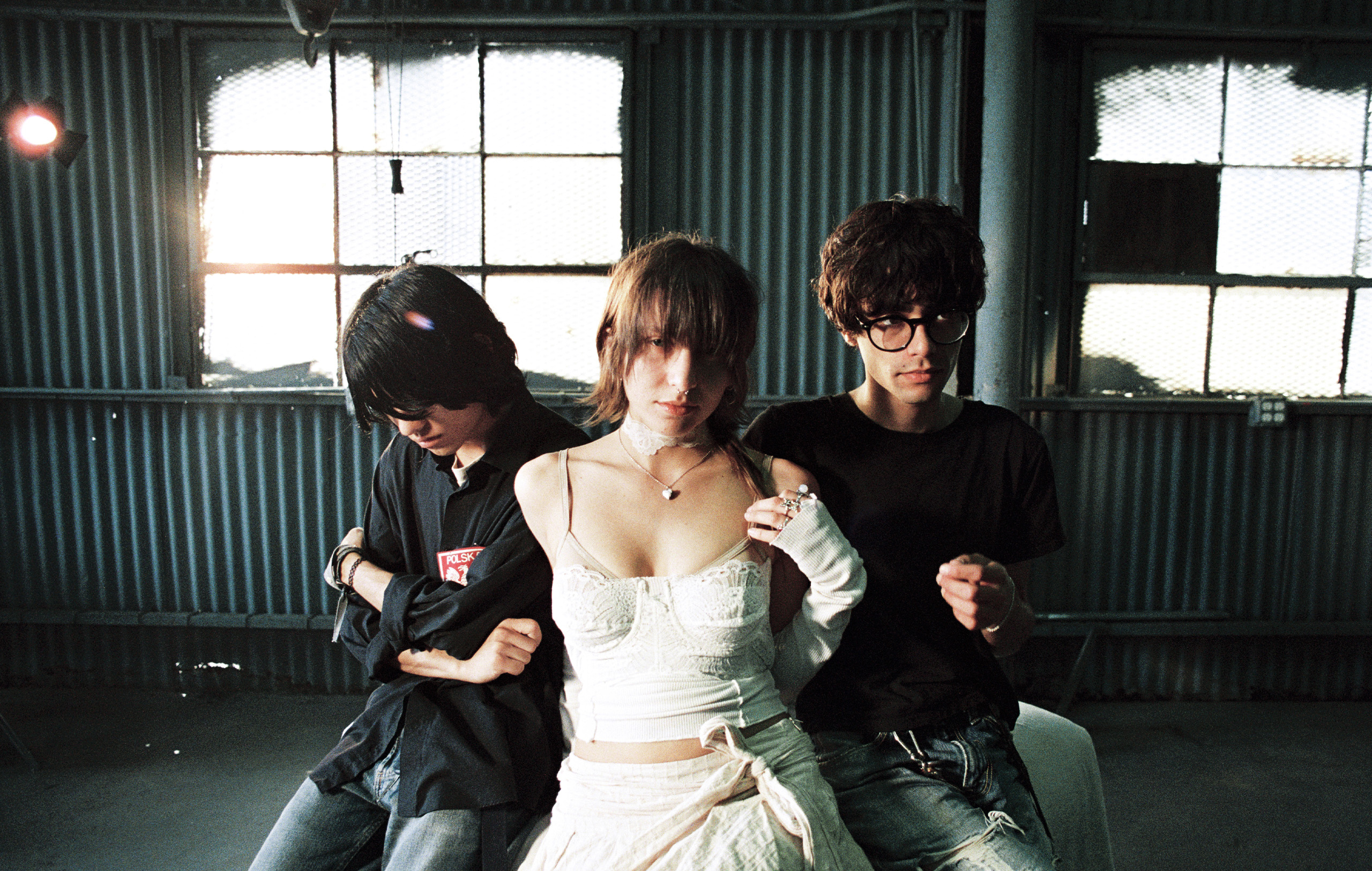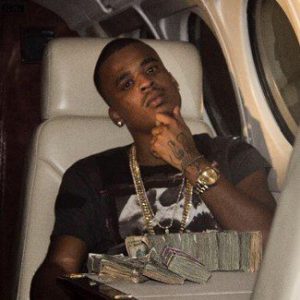Keyan Pourzand just wanted to avoid embarrassment. It was April 2020 – at the very dawn of the pandemic – and the guitarist/vocalist and his teenage bandmates in Julie, Alexandria Elizabeth (vocals/bass) and Dillon Lee (drums), were about to upload their debut single ‘Clairbourne Practice’ to streaming services. “You know how Spotify has that ‘less than’ sign for songs that have less than 1,000 listens?” asks Pourzand rhetorically. “We all just said: ‘Please let us have more than that.’”
Julie on The Cover of NME. Credit: David Milan Kelly for NME
Pourzand needn’t have worried. The uploaded track, the multi-movement maelstrom known as ‘Flutter’, blew past 1,000 streams inside of a week – on its way to an astonishing 36million and counting just on Spotify alone. That’s even more impressive when you consider that Julie are hardly the typical viral pop sensation that racks up those kinds of numbers. They’re an arty three-piece who look to Sonic Youth, The Swirlies and the even more obscure, un-Spotify-able noise purveyors Henry’s Dress for inspiration. And good luck finding the Julie TikTok account. It doesn’t exist.
While ‘Flutter’ could have been both the beginning and the end of the story for Julie – like so many other ‘here today, gone tomorrow’ acts that enjoy fleeting algorithmic success – they’ve been able to use their smash debut single as a springboard. The band have since signed a major label deal with Atlantic Records, released their debut album ‘My Anti-Aircraft Friend’ on September 13, and have opened for a bevy of heavy hitters from Alex G to Faye Webster to Foo Fighters. The band have also proven more than capable of standing on their own two feet, having played a slew of sold-out headlining dates across the US and UK.
“The shoegaze label has helped us, but I don’t want to be tied to it forever” – Dillon Lee
The day of NME’s interview represents something of a full circle moment for the band. In a few short hours, they are due to play a headline show at the Hawthorne Theatre in Portland, Oregon, and it was almost exactly two years ago in this very city where they not only played their first headline show outside of southern California but also began to realise their own potential. “We were extremely nervous,” Elizabeth recalls. But those fears dissipated almost immediately once they got onstage: “We’d never had that kind of reaction. The crowd just started going crazy and didn’t stop. It was the first time I remember feeling really confident in my live performance.”
The power of live performance is a recurring theme for Julie. The band owes their very existence to the short-lived local scene in Orange County, the sprawling suburban area outside of Los Angeles. It was Lee who first introduced his high school classmate Pourzand to local legends like Red Theme, Blivet and Kevlar. “I didn’t go to shows until I met Dillon,” admits Pourzand. “I was actually shocked that people our age were playing live, and it was incredibly inspiring.”
Pourzand claims he had very little exposure to indie or pop music prior to high school. His parents emigrated to the States in the ’80s, his father fleeing the revolution in Iran. “[My parents] played some music like The Cure and Joy Division, but for the most part, I couldn’t tell you what was being played because it was in Arabic.” He gladly tagged along with Lee to many of the local shows, and it was at one of those gigs that they met Elizabeth through mutual friends.
Keyan Pourzand of Julie. Credit: David Milan Kelly for NME
Unlike Pourzand and Lee, Elizabeth had developed her interest in music early on. Her father had been a musician in the late ’80s and early ’90s, and her parents had even met at renowned Sunset Strip venue, The Roxy. When Lee and Pourzand approached her about their fledgling project – which at that point, per Lee, was “just Keyan and I playing in my kitchen on weekends” – she had zero hesitation.
The band’s first practice took place in May 2019, and the band’s signature squally sound – equal parts shoegaze, noise-pop, and jagged indie-rock – quickly coalesced. In less than three months, the band played their very first gig in the backyard of a friend’s house and managed to squeeze in a handful of additional shows, mostly at non-traditional venues, prior to the pandemic shutdown.
Yet despite the intrusion of the pandemic, Julie remained fully committed to the idea of making music designed to be performed live. Again and again throughout our interview, the band emphasise that no computers are used in the creation of their music – to the occasional frustration of their outside collaborators. Elizabeth recalls one moment in particular with some amusement: “We sent our manager the four demos we were going to properly record for our first EP, and he was like ‘OK, cool.’ And then he later told us that he never sent them to our producer because they were so indecipherable.” Pourzand concedes that their “cacophony of noise” demos, which are nothing more than iPhone voice memos, might not be terribly helpful as a recording roadmap, but he firmly believes that this approach of developing the songs through live performance is critical to their success.
Alexandria Elizabeth of Julie. Credit: David Milan Kelly for NME
Since 2020, there has been no shortage of shoegaze and shoegaze-indebted acts cropping up and gaining attention. Julie were among the earliest to enjoy the spoils from the renewed interest in the pedal-enamoured genre; however, they remain justifiably conflicted about the categorisation. “It’s cool because it’s helped us grow, but I think we’re getting a little sick and tired of it,” admits Pourzand.
Lee is even more direct: “It’s helped us, but I don’t want to be tied to that label forever. There are plenty of other aspects to our sound.” He’s not wrong. While traditional shoegaze often deemphasises rhythm in favour of layers upon layers of roaring feedback, Julie songs, especially on their debut album, are constructed with strong rhythmic foundations where the bass and drums receive equal billing to the guitar.
“If more artists focused on art and music and playing live rather than social media, they’d be just fine” – Keyan Pourzand
First single ‘Clairbourne Practice’ is most reminiscent of Oxford’s Swervedriver, who, at their ‘Mezcal Head’ peak, expertly balanced shoegaze’s more ethereal tendencies with a grungy, propulsive cool. Elsewhere, on songs like ‘Very Little Effort’ and ‘Feminine Adornments’, you can also pick up hints of Deftones’ moody, gaze-adjacent metal circa ‘White Pony’. More importantly, Julie’s egalitarian musical approach – not privileging one instrument over the others – reinforces the idea that the band operates as a unit and that each band member is essential to the Julie sound. It stands in stark contrast to the increasingly long list of nu-gazers found on the popular “Shoegaze Now” Spotify playlist. “A lot of these are solo projects first, and then they have to find a band,” says Elizabeth. “Because we write the music in person in real life, and then we record it, it’s just different.”
Different also describes how they present themselves and interact online. Unlike other artists who post constantly out of fear of losing their audience or post content that has nothing to do with their art, Julie have remained steadfast in their belief that it’s possible to cultivate a real online fanbase without blindly following trends. Pourzand confesses that he has a “strong distaste for seeing that type of content from other bands”. He believes that if more artists put “focus on art and music and playing live, they’d be just fine”. The band’s Instagram feed is mostly filled with hand-made art designed collectively by the band (Pourzand and Elizabeth both attended architecture school). According to Pourzand, they feel no pressure from anyone to change their content or increase the frequency of their posts. “We actually made it a part of our contract. We can do whatever we want.” Adds Elizabeth: “We would never have signed something that forced us to ruin this.”
Dillon Lee of Julie. Credit: David Milan Kelly for NME
‘My Anti-Aircraft Friend’ is clearly a product of a band uncompromised. It’s loud, brash, and, at times, deliberately confrontational – a welcome anomaly among major label releases in 2024. That uniqueness extends to the process that birthed it. Rather than halt touring and devote themselves with monastic intensity to recording, which their new label backing might have afforded them, the band instead opted for a more fluid arrangement, booking short stints at various studios across California in between tours. The approach gives the songs a loose, unfussed quality – almost as if you’re hearing the band stumble onto them for the very first time. And it preserves Julie’s commitment to capturing the thrill of live performance, a through-line for all their recorded output to date. As Lee puts it: “The goal was to keep doing what we do but elevated with the better knowledge we now have.”
Of course, even if the creative process remains more or less the same, the band’s circumstances are anything but. A real community has sprung up around Julie, and it has not gone unnoticed by Pourzand, Lee, and Elizabeth. They feel pressure now, but it’s pressure of a different kind – not to exceed some arbitrary standard they’ve set for themselves but rather to, in Elizabeth’s words, “be good because, you know, now people give a fuck”.
And certainly, there’s no shame in that.
Julie’s ‘My Anti-Aircraft Friend’ is out now via Atlantic Records.
Listen to Julie’s exclusive playlist to accompany The Cover below on Spotify and here on Apple Music.
Words: Jonathan Garrett
Photography: David Milan Kelly
Label: Atlantic Records
The post For high-flying nu-gazers Julie, the sky’s the limit appeared first on NME.




